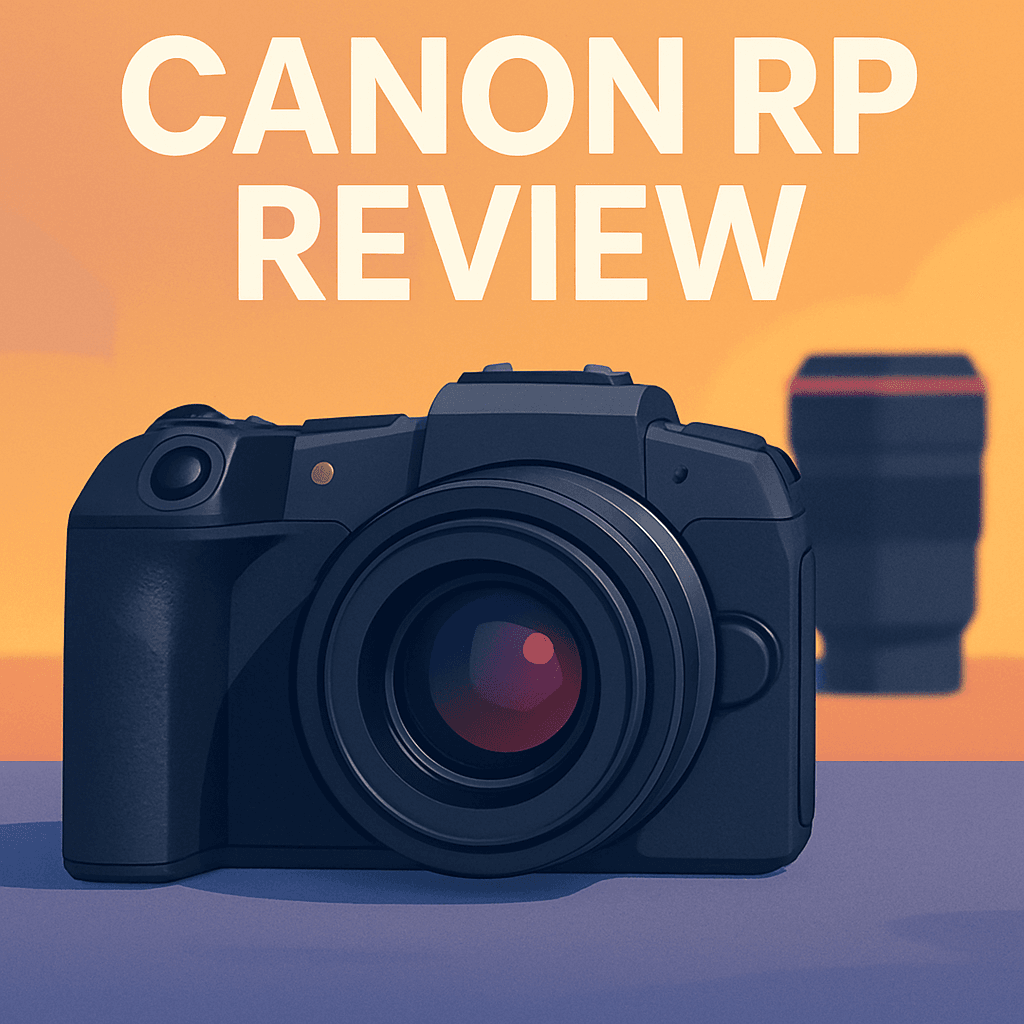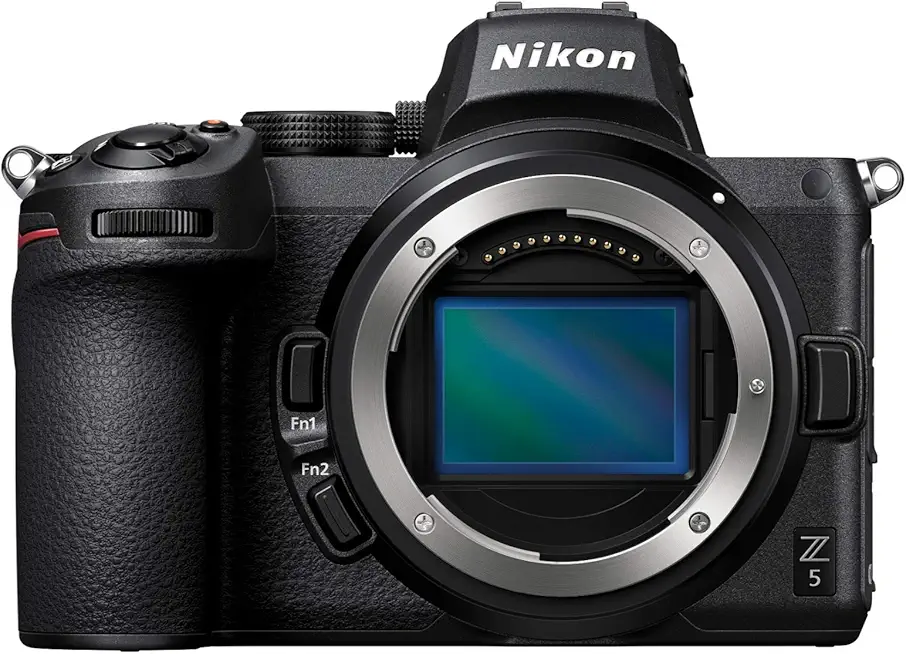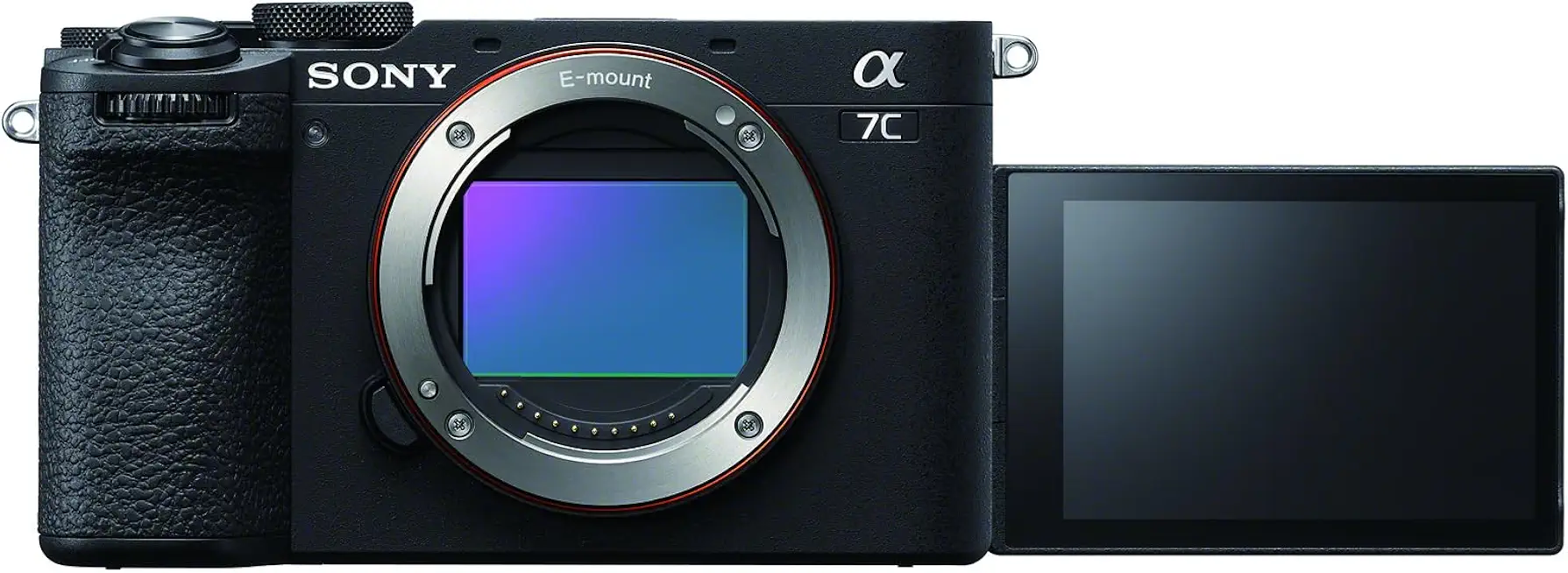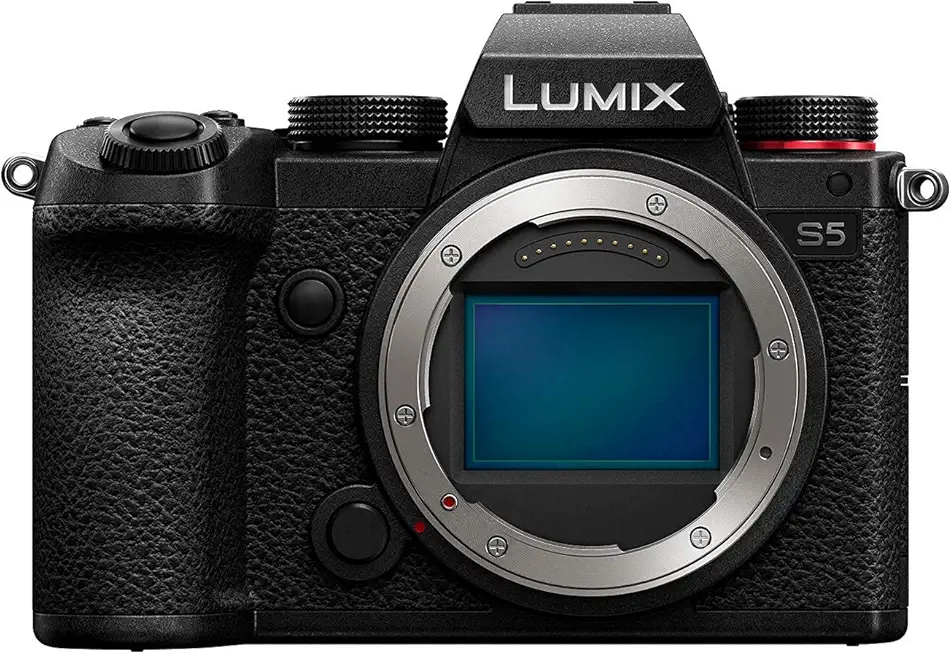
Tired of lugging a bulky camera when you want real full-frame results? If portability matters, you’ll care what follows.
I field-tested the Canon EOS RP Camera against “a couple of close rivals”. I shot in cities, on trails, and in studio light to see real-world strengths and flaws.
Its biggest perks are tiny size, pleasing color, and reliable eye-detection that helps portraits pop. In practice you’ll get great-looking photos without a heavy kit.
It’s aimed at enthusiasts, travel shooters, portrait photographers, and beginners who want full-frame ease. The headline compromise is video — the 4K is cropped and lacks professional video features.
Handling is intuitive with a flip screen and comfy grip. Just know battery life is modest, so bring a spare for long days.
Payoff: better photos and a lighter bag. So keep reading as I’ll reveal something shocking about the Canon EOS RP Camera that might change your photo quality drastically.

Canon EOS RP Camera
Compact full-frame mirrorless designed for photographers and vloggers seeking stunning image quality in a lightweight body. Fast autofocus, intuitive vari-angle touchscreen, and versatile performance for everyday shooting and travel adventures.
Check PriceThe Numbers You Need
| Spec | Value |
|---|---|
| Sensor | 26.2 MP full-frame CMOS |
| Image processor | DIGIC 8 |
| Autofocus | Dual Pixel CMOS AF — 143 AF points, 4,779 manually selectable positions |
| Eye AF | Eye AF with pupil detection |
| AF low-light sensitivity | AF down to EV -5 (center point) |
| ISO range | Native 100–40,000; expandable to 50–102,400 |
| Continuous shooting | Up to 5 fps (full-time AF); 4 fps in Servo AF |
| Viewfinder | 0.39″ OLED EVF, 2.36 million dots, 0.7x magnification |
| Rear LCD | 3.0″ fully articulated touchscreen, 1.04 million dots |
| Video recording | 4K (cropped) at 23.98/25p; 1080p up to 60p |
| Video limitation | No Dual Pixel AF in 4K (contrast-detect only) |
| Image stabilization | Dual Sensing IS (lens-based), up to ~5 stops (with compatible lenses) |
| Memory card slot | Single UHS-II SD card slot |
| Battery life | CIPA-rated ≈250 shots |
| Weight | 485 g (with battery and card) |
How It’s Built
The Canon EOS RP Camera is ridiculously small and light for a full-frame body, and that shows as soon as you pick it up. In my testing the polycarbonate shell felt surprisingly solid and the metal lens mount inspires confidence when swapping glass. For real shooting that means less shoulder strain on long days and an easy travel companion.
The grip is unexpectedly comfortable even with the compact footprint. I found I could hold and shoot for extended periods, though big lenses still make it front-heavy—so beginners should try it with their intended lenses before long outings.
Controls are intentionally simple, with no second status display or a touch bar to clutter the top plate. The fully articulated touchscreen is one of my favorite bits; in my testing it was responsive and makes vlogging, selfies, and low-angle shots dead simple.
One thing I really liked was how solid the mount and chassis feel despite the lightweight construction. One thing that could be better is the weather protection; after using it in misty conditions I treated it like a fair-weather buddy. Bottom line: great for travel and beginners, but keep a rain cover handy for rough conditions.
In Your Hands
The Canon EOS RP delivers image quality that punches well above its compact size. Colors are pleasing straight from the camera and the files hold a commendable amount of dynamic range, making skin tones and landscapes both enjoyable to shoot and easy to work with in post.
In practical shooting the RP handles higher sensitivity settings gracefully, with noise kept under control for typical low-light situations. When light gets truly scarce you can still get usable results in a pinch, though shadows and fine detail will require a more careful approach.
Autofocus is snappy and dependable in good light, and the eye-detection does a solid job for portraits, helping you concentrate on composition rather than focus hunting. The system can be challenged by very dim scenes or fast-moving subjects, so fast-action shooters may notice limits during demanding sequences.
Video is straightforward and produces clean, detailed full HD footage that will satisfy casual creators. The camera’s 4K mode is usable for stills and short clips, but it comes with cropping and a simpler autofocus behavior and lacks pro-level log and color tools, so it’s less appealing for serious videographers.
Handling feels intentionally simple: the menus, Creative Assist, and the articulating touchscreen make the RP approachable for beginners and travelers. Battery life and a single card slot are practical compromises for the lightweight body; most users praise the portability and color science but commonly carry spares and accept the storage trade-offs for everyday shooting.
The Good and Bad
- Lightest and smallest Canon full-frame body, highly portable
- Strong image quality for portraits and travel photography
- User-friendly interface and helpful features for beginners
- 4K is cropped, lacks Dual Pixel AF in 4K, and misses advanced video features like C-Log
- Mediocre battery life requiring spares for extended use
Ideal Buyer
If you’re an enthusiast looking for an affordable way into full-frame photography, the Canon EOS RP Camera is a smart first step. It balances strong image quality and approachable usability without the bulk or price of pro bodies. It’s ideal for photographers who want true full-frame depth without a steep learning curve.
Travel photographers who prioritize compact size and light weight will love its tiny footprint and comfortable grip. The low weight and fully articulated touchscreen make long days and odd-angle shooting noticeably easier. Street and landscape shooters will appreciate slipping it into a carry-on or daypack and barely feeling the weight.
Portrait shooters who care about natural skin tones and dependable Eye AF will get excellent results straight out of camera. The RP’s pleasing color science and pupil-detecting autofocus simplify controlled studio and on-location sessions. For small teams or solo shooters, it speeds workflow while keeping image quality high.
Beginners who want an easy, forgiving full-frame experience will like the intuitive menus and Creative Assist features. Serious video creators and professionals who need rugged bodies, long battery life or dual card slots should look elsewhere. The RP isn’t the best pick if you require uncropped 4K, advanced log profiles, or pro-grade weather sealing.
Better Alternatives?
We’ve already gone over the Canon EOS RP and what makes it a great, tiny full-frame camera — light, easy to use, and very friendly for portraits and travel. But if you need different tools for your work — stronger stabilization, tougher build, better video, or faster tracking — there are other bodies that solve those exact issues.
Below I’ll walk through three real-world alternatives I’ve used. For each one I’ll say where it beats the RP, where it falls short, and what kind of shooter would pick it over Canon’s little full‑frame body.
Alternative 1:


Nikon Z5 Camera
A robust full-frame camera offering high-resolution stills and confident low-light performance. Weather-sealed build, comfortable handling, and dependable autofocus make it a solid choice for enthusiasts and serious hobbyists.
Check PriceThe Nikon Z5 brings built-in stabilization and a more robust feel compared with the RP. In the field I noticed handheld shots — especially at slower shutter speeds for landscapes or dusk portraits — came out steadier without relying on stabilized lenses. The dual memory card slots and slightly better weather sealing give you a safety net on longer jobs that the RP’s single slot and lighter body don’t offer.
Where the Z5 loses to the RP is size and weight: it’s a bit heavier and not as pocketable for day-long travel. Nikon’s menu and handling felt different to me, and for quick, flattering skin tones straight out of camera I still prefer Canon’s color for portraits. Autofocus is solid, but I found Canon’s Eye AF on the RP to be a touch more intuitive for quick portrait sessions.
Choose the Z5 if you want a small-but-solid full-frame that can take a few more bumps, keep shooting longer with dual cards, and give you built-in stabilization for handheld work. It’s great for landscape shooters, hobby wedding photographers, and anyone who wants more shooting security than the RP offers.
Alternative 2:


Sony Alpha 7C II Camera
Ultra-compact full-frame powerhouse engineered for creators who demand mobility without compromise. Advanced autofocus, excellent image quality, cinematic video capabilities, and long battery life deliver professional results in a travel-friendly form factor.
Check PriceThe Sony A7C II is the closest rival if you love the RP’s tiny footprint but want stronger autofocus and built-in stabilization. In real shoots I found Sony’s tracking and eye detection kept up with kids running around or fast-moving street subjects better than the RP, and handheld video felt smoother thanks to the body stabilization.
On the downside, the A7C II keeps the small camera trade-offs: a compact grip that can feel cramped with bigger lenses and a menu system that took me longer to customize than Canon’s simpler layout. Lens choices and prices can also push your kit cost higher. For straight portrait color and the simplest out‑of‑camera look, I still reached for the RP at times.
If you’re a travel shooter who needs excellent AF, a long battery life, and better video in a tiny package, the Sony makes a lot of sense. It’s ideal for run‑and‑gun content creators, street photographers who want quiet and light gear, and hybrid shooters who switch between stills and video frequently.
Alternative 3:


Panasonic LUMIX S5 Camera
Hybrid full-frame tool optimized for filmmakers and photographers: impressive video specs, effective in-body stabilization, rich color profile options, and a compact, weather-resistant chassis for on-location shoots and studio work alike.
Check PriceThe Panasonic S5 is the one I grab when video matters. In practical use the S5 gives me cleaner long takes, better recording options, and very usable built‑in stabilization that lets me handhold rolling shots without a gimbal for many situations. The color and profile options also make it easier to grade footage later compared with the RP’s limited video features.
That said, the S5 isn’t as small as the RP and the autofocus for fast-moving stills didn’t always match Canon’s ease for portraits in every situation. If you mostly shoot photos and want the lightest kit, the RP still wins. The S5 shines when you need video-first tools on location and don’t mind a slightly larger body.
Pick the Panasonic S5 if you’re a hybrid shooter or filmmaker who needs strong video tools and steady handheld performance. It’s great for short films, interviews, and wedding videographers who want more control over footage than the RP can offer, while still keeping the kit fairly compact.
What People Ask Most
Does the RP have in-body image stabilization (IBIS)?
No. Stabilization is lens-based Dual Sensing IS, rated up to about 5 stops.
Can the RP shoot uncropped 4K or 4K 30p?
No. 4K is cropped and limited to 23.98/25p, with no 4K 30p option.
Is Dual Pixel AF available when recording 4K video?
No. 4K recording uses contrast-detect AF rather than Dual Pixel AF.
How many memory card slots does the RP have?
One UHS-II SD card slot.
What is the battery life like?
CIPA-rated at around 250 shots, so it’s below average for mirrorless and you should bring spare batteries for long days.
Is the body weather-sealed?
It has limited weather sealing and is not as rugged or fully weatherproof as professional bodies.
Conclusion
The Canon EOS RP Camera is a rare full-frame offering that puts image quality and portability ahead of headline specs. Its compact, lightweight body and intuitive controls make shooting all day feel easy, and the Eye AF delivers consistently flattering portrait results that will please enthusiasts and serious hobbyists. For travelers and portrait shooters who value color and simplicity, it’s a joy to use.
That said, the RP is not a do-everything tool. Video features are intentionally limited, battery life is modest, and the single card slot and modest weather protection reduce its appeal for demanding or professional workflows. Plan on carrying spares and accepting a few compromises if you want the convenience of this small full-frame package.
Put simply, the RP is a smart, affordable entry to full-frame photography that favors stills, portability, and ease of use over pro-level durability and cine features. If your priority is great images and lightweight handling for travel or portraits, it’s an excellent value. If you need robust video, dual cards, or heavy weatherproofing, look elsewhere.



Canon EOS RP Camera
Compact full-frame mirrorless designed for photographers and vloggers seeking stunning image quality in a lightweight body. Fast autofocus, intuitive vari-angle touchscreen, and versatile performance for everyday shooting and travel adventures.
Check Price




0 Comments